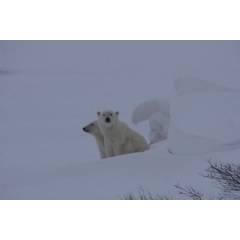Northrop Grumman and San Diego Zoo Global Successfully Use New Autonomous Technology to Collect Arctic Sea Ice Data
A team of San Diego Zoo Global scientists and Northrop Grumman Corporation (NYSE: NOC) engineers have returned home from a successful trip aimed at collecting sea ice data in Canada’s Hudson Bay. This was the second year of a unique collaboration to better understand the performance requirements for new technology used to study critical polar bear habitats. The ultimate goal is to more precisely monitor sea ice habitat in a changing climate, in order to better inform future conservation strategies.
During the mission, named Operation #PolarEye, the team used a customized unmanned aircraft system (UAS) to provide a more detailed, finer-scale view of sea ice habitat, and to observe polar bears without disturbing the animals or posing a risk to humans. Equipped with four integrated sensors operating simultaneously, the UAS flew 11 sea ice mapping missions and collected an array of habitat data, including three-dimensional sea ice maps and multispectral data, both collected at sub-centimeter resolution. The team also tested the ability of the UAS to detect tracks and signs left behind by polar bears as they migrate from land to sea ice.
“This mission demonstrates what is possible when advanced technology is integrated into conservation research for threatened species like the polar bear,” said Dr. Nicholas Pilfold, scientist for San Diego Zoo Global. “To be able to analyze polar bear habitat in three dimensions will allow us to answer pertinent questions that have previously eluded scientists.”
The battery powered autonomous system was able to withstand air temperatures as low as -13 degrees Fahrenheit (-25 degrees Celsius), which drove temperatures down to -31 degrees Fahrenheit (-35 degress Celsius)
“Our team was able to leverage Northrop Grumman’s expertise in autonomous technology and sensor integration to deliver a cutting-edge system for San Diego Zoo Global’s Arctic mission,” said Charlie Welch, Operation #PolarEye technical lead for Northrop Grumman. “Operation #PolarEye was a success because our UAS and our San Diego Zoo Global-Northrop Grumman team were prepared to operate in extreme Arctic conditions.”
Operation #PolarEye consisted of two San Diego Zoo Global scientists and five Northrop Grumman engineers. The team spent 10 days collecting data at a remote facility 25 miles (40 kilometers) north of the town of Churchill, Manitoba.
ABOUT SAN DIEGO ZOO GLOBAL
Bringing species back from the brink of extinction is the goal of San Diego Zoo Global. As a leader in conservation, the work of San Diego Zoo Global includes on-site wildlife conservation efforts (representing both plants and animals) at the San Diego Zoo, San Diego Zoo Safari Park, and San Diego Zoo Institute for Conservation Research, as well as international field programs on six continents. The work of these entities is inspiring children through the San Diego Zoo Kids network, reaching out through the internet and in children’s hospitals nationwide. The work of San Diego Zoo Global is made possible by the San Diego Zoo Global Wildlife Conservancy and is supported in part by the Foundation of San Diego Zoo Global.
ABOUT NORTHROP GRUMMAN
Northrop Grumman is a leading global security company providing innovative systems, products and solutions in autonomous systems, cyber, C4ISR, strike, and logistics and modernization to customers worldwide. Please visit news.northropgrumman.com and follow us on Twitter, @NGCNews, for more information.
( Press Release Image: https://photos.webwire.com/prmedia/6/218080/218080-1.jpg )
WebWireID218080
This news content was configured by WebWire editorial staff. Linking is permitted.
News Release Distribution and Press Release Distribution Services Provided by WebWire.
